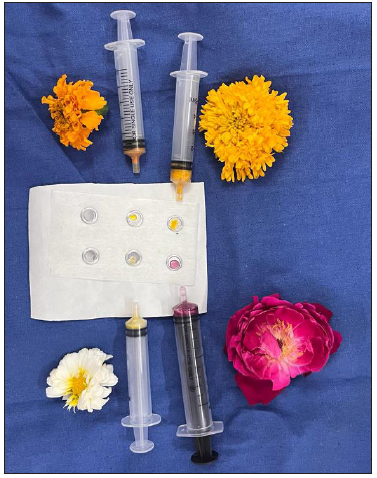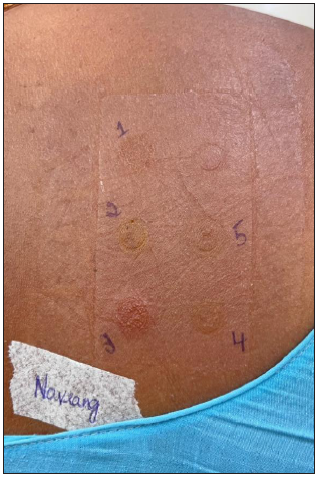Translate this page into:
A new method for extracting flower antigen in “as is” form
Corresponding author: Dr. Ramesh Kumar Kushwaha, Departments of Dermatology, Venereology and Leprosy, Government Medical College, Rangbari, Kota, India. kush_ramesh3@yahoo.com
-
Received: ,
Accepted: ,
How to cite this article: Kushwaha RK, Rakshitha V, Jain SK, Yadav DK. A new method for extracting flower antigen in “as is” form. Indian J Dermatol Venereol Leprol. 2024;90:416-7. doi 10.25259/IJDVL_805_2023
Problem
Ever since we have been using patch tests, extracting the etiological agent or the allergen in “as is” form for diagnosing various allergic contact dermatitides has been the biggest challenge. A female flower vendor presented to the Dermatology outpatient department with complaints of facial swelling, itching, and oozy lesions over the face and both hands. She had a history of using different types of seasonal flowers in summer for making garlands and also mentioned frequent use of a local flower called Navrang (Tagetes erecta). To test for the allergen, there was no readymade kit available.
Solution
The usual method of extracting flower antigens is by freeze drying and grinding to obtain a homogenous sample, or by using a solvent system to extract the bioactive component. It is a prolonged and expensive process and requires solvent systems and skilled professional experts. Our method is simple, quick, and does not sensitise healthcare professionals to antigen, uses controlled dosing of antigens, and simulates the conventional method of a patch test kit. We came up with the idea of extracting flower antigens in “as is” form by referring to Hassan et al.1,2 We carefully plucked a few petals separately from each variety of flowers that the patient had been working with. The petals were partially crushed manually and inserted into a sterile syringe after removing the plunger. The plunger was then strongly pressed until a fluid extract came out of the nozzle (allergen) [Figure 1a, Video 1a]. This extract was used as an allergen for the patch test [Video 1b]. The patch test showed 2+ (strong positive) results after 48 h [Figure 1b], 72 h and 96 h only against the allergen extracted from Tagetes erecta (Navrang flower). It did not show any reactions to other flower extracts. There is a note of caution: strong allergens like parthenium flowers may not be used as such, as they may sensitise the patient.

- Patch test strip with allergen extract.

- Patch test result after 48 h.
Declaration of patient consent
The authors certify that they have obtained all appropriate patient consent.
Financial support and sponsorship
Nil.
Conflicts of interest
There are no conflicts of interest
Use of artificial intelligence (AI)-assisted technology for manuscript preparation
The authors confirm that there was no use of artificial intelligence (AI)- assisted technology for assisting in the writing or editing of the manuscript and no images were manipulated using AI.
References
- Contact dermatitis in saffron workers: Clinical profile and identification of contact sensitizers in a saffron – cultivating area of Kashmir valley of north India. Dermatitis. 2015;26:136-41.
- [CrossRef] [PubMed] [Google Scholar]
- Contact dermatitis caused by tulips: Identification of contact sensitizers in tulip workers of Kashmir Valley in North India. Contact dermatitis. 2018;78:64-9.
- [CrossRef] [PubMed] [Google Scholar]





